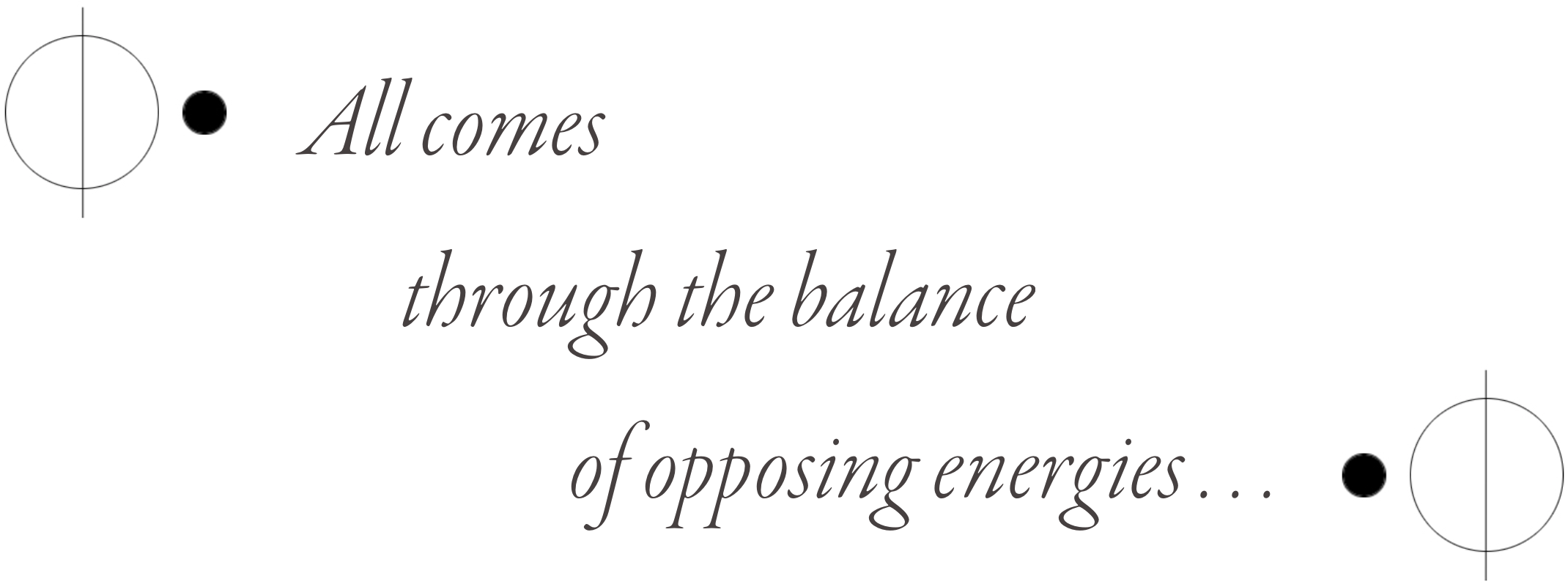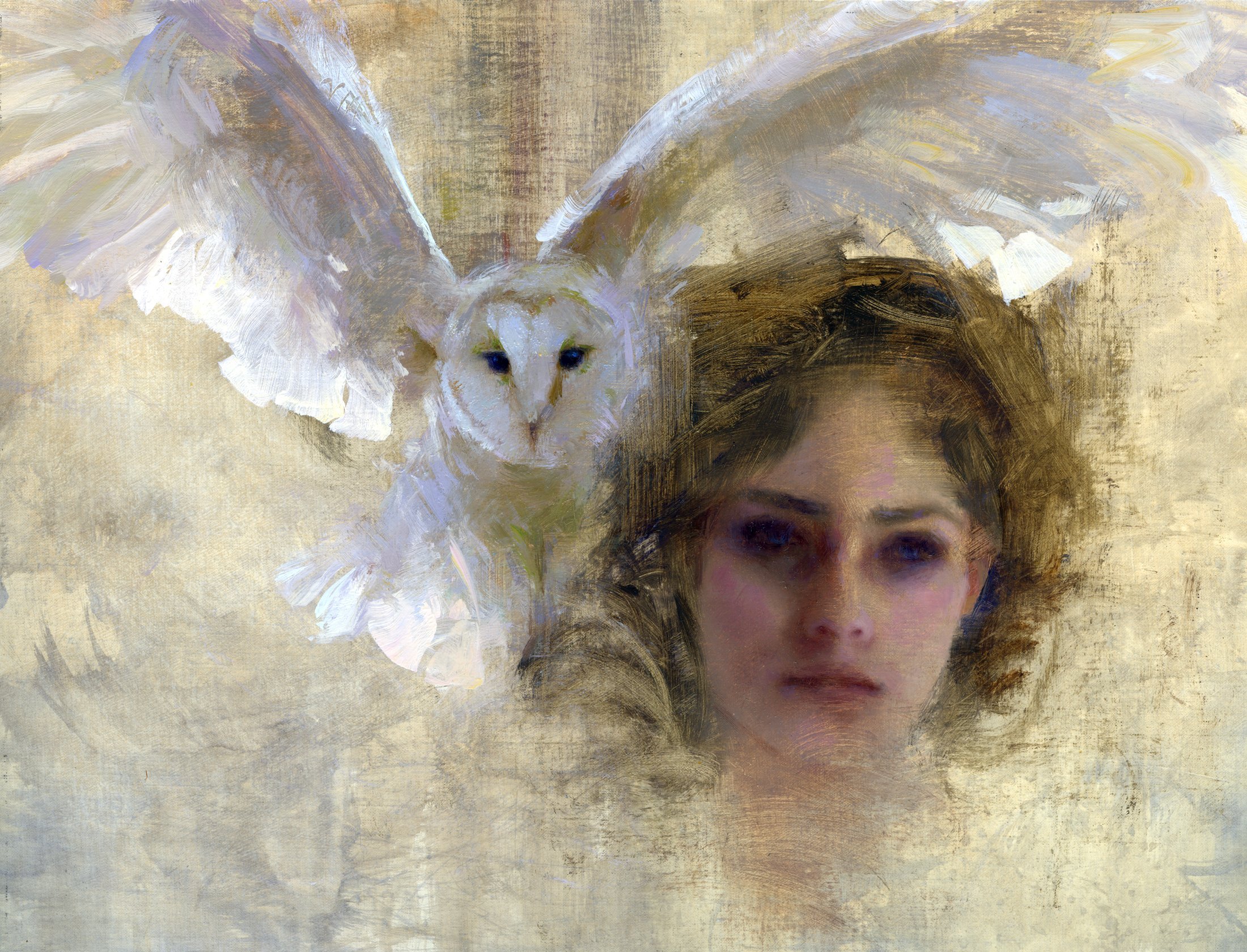Brushwork and the Breath
Brushwork and the Breath
By KATIE SWATLAND
“One brushstroke at a time, one breath at a time . . .”
I: THE POWER OF THE BREATH
PAINTING FROM THE ‘ALCHEMY VISIONS’ COLLECTION.—OIL ON BIRCH BARK, 22 X 10
Every painting is built one brushstroke at a time and one breath at a time—with the rise and fall of each breath corresponding to the movement of the brush across the canvas. The connection of the breath to the brush is a subtle detail that holds great power.
When I run into trouble in the progress of a painting, I can always trace it back to my breath. I find in these moments that my breath has become shallow, or I’ve stopped breathing all together. It carries over to my body, with my posture contracting and my shoulders and neck constricting with tension. I’ve had to learn the hard way, though many failed paintings, that pushing through these points and forcing to find a solution to my roadblock only leads to disappointing results. Disappointing results not only with the painting itself, but in the experience, as I have diverted attention away from the reason I create in the first place. I’ve forgotten the present moment, and rerouted my attention elsewhere. I usually end up having to re-paint that section, or starting the painting over all together.
Experience has taught me in these moments . . . to pause . . . to return to the breath and re-group. I’ve found that through slowing down and centering each movement around the breath, that the process of painting comes easier, is more enjoyable, and I am better able to recognize when I have arrived at my final destination of the finished painting.
“Etymology and the history of language itself show us that breath has always been linked to life. In the linguistic roots of Latin and Greek, the names given to the soul or the spirit are directly connected to or synonymous with the breath. The Latin words animus (spirit) and anima (soul) are the same as the Greek anemos, meaning ‘wind.’ Another Greek word for wind, pneuma, also means ‘spirit.’ Our ancient ancestors often associated breath with the soul, since breath takes on a misty, ghostly shape in cold weather.
Historically breath is what gives us our soul or spirit, but we also know that breath quite literally sustains life. The strength and vitality of the body is maintained through the balance of oxygen and carbon dioxide at a cellular level. In fact, as we will demonstrate, Western medical research shows that our overall health is directly related to how we breathe.”
— Excerpt from The Tibetan Yoga of Breath by Anyen Rinpoche & Allison Choying Zangmo
In this way, I like to think of the breath as giving life to a painting. Vibrance, vitality, movement, and spirit may all be obtained and expressed through the connection of the breath with the brush. In the following, I share with you a painting demonstration that illustrates how I like to use brushwork to first capture the energetic signature of my subject, from which I then reveal and articulate the form. I also share brushwork exercises I find helpful in unlocking the possibilities contained within the brush, which is tremendously useful in understanding how to interpret the visual world in terms of brushstrokes.

II: Expressing Movement
Movement is undoubtably expressed through brushwork. The interplay between atmosphere and motion can be powerfully articulated through directional and expressive brushstrokes. In the following demonstration, I show how I painted a dear friend of mine, while he sat in my studio and played some of my favorite tunes. In the beginning brushwork, I was after capturing his motion, and the vibrational sounds he was creating with his guitar and voice. It was then simply a matter of pulling his form out of the momentum of this initial brushwork, and sculpting his features from the energetic strokes.
Shown below is the completed painting. I find it extremely helpful to first capture the movement and energy of my subject, as it serves as a guide to reveal the form. Every subject has a different energetic signature, and thus requires a unique block-in, which can change depending upon what I wish to express of my subject. The underlying structure has a huge influence upon these beginning brushstrokes. (I have written an article that explores the importance of the underlying structure that can can be found here [link forthcoming).
“The skill of good observation, the ability to convey the three-dimensionality of form convincingly, and the cultivation of edge, color and value sensitivity—all stem from an understanding of the nature of the underlying structure.” – Swatland
RYAN MONTBLEAU.—oil on panel, 12 x 18
III: Brush Mastery Exercises
Discovering the capabilities of our brushes is essential to broadening the spectrum of possibilities contained within our paints, and to expanding the vocabulary from which we can draw, to bring visual form to an idea. In order to effectively portray these ideas on canvas, it is necessary to develop the skills to envision our subjects as paintings, and the ability to translate what we experience into layers of physical paint. Exploring how brushes can apply paint helps tremendously in understanding how to interpret the visual world in terms of brushstrokes.
In the following I share brush exercises that I’ve found helpful in the pursuit of achieving mastery over these tools. I recommend practicing them often, treating them as opportunities to explore. Set this time aside to play and to try new things. Make it a habit to keep a few scrap pieces of canvas on hand to encourage frequent study. The experience gained through these drills will carry over when painting your chosen subjects. Remember, the goal is to develop a vocabulary of shapes from which to draw upon when translating the visual field into bits of color. Over time, you will find yourself assessing a scene and knowing exactly how you will apply the paint in order to best communicate your vision.
From THE ‘Alchemy Visions’ Collection.—oil & birch bark on custom ground, 13 x 18

Unlocking the Possibilities
Each brush contains a wide variety of options. It may not appear so at first, but often, one brush can mimic the strokes of many others. It just takes a little exploration to unlock the possibilities contained in each individual brush. For example, a large flat bristle can not only create wide, sweeping, painterly strokes, but also very fine lines, and everything in between simply by using the different edges and angles of the brush.
The three studies of grass, shown below, illustrate the versatility that one brush can provide. Each was painted with the same size 16 flat bristle. By varying how I used the brush, I was able to achieve three distinct looks.
The top grass and water were created by using the corner of the brush. I varied the pressure, as well as the directions of the strokes to create the tones. For the middle study I made sure the brush was very dry. I then loaded it with paint and first made vertical strokes. I mixed a lighter value and then, with the brush loaded again, lightly dragged it horizontally across the top to describe the light falling on the grass. This created a beautiful dry brush effect and interesting edges. For the bottom study, I applied a mineral spirit wash, and then, with the chiseled edge of the brush, pulled out a few thin strands for the blades of grass.
Take time to become acquainted with the capabilities of each brush. Choose one, lock the rest away, and spend an afternoon studying nature.
2. Angle of Attack
Adjusting the angle the brush hits the canvas can have a profound effect on the quality of a stroke and the edges created. This is similar to the way a piano player can achieve a variety of sound textures simply by varying the attack on the keys. Henry F. Peru, a pupil of Frédéric Chopin, was recorded to have said, “He made me practise first of all constantly varying the attack of one singe note, and showed me how he could obtain diverse sonorities from the same key, by striking it in twenty different ways.” (Chopin: Pianist and Teacher, As Seen by his Pupils, Cambridge Univeristy Press Ltd., 1986).
This is a great idea to keep in mind when exploring the many ways a brush can strike the canvas. Experiment attacking the canvas in as many different ways you can imagine. Approach it head on with the brush perpendicular to the canvas, or press it flat and then release it. Roll it across, or drag it horizontally and then twist it, turning it on edge to continue the stroke. Experiment with all different combinations and ways to apply the paint. Pay attention to the quality of edges created, and file these results away in your memory. Next time you need a specific edge or characteristic stroke to express your subject, you will know just how to create it on your canvas!
THE SECRET IN THE GARDEN.—oil on panel, 8 x 12
3. Holding and Loading the Brush, and Strong Direction
There are many ways a brush can be held. Holding the brush close to the bristles can sometimes offer better control when painting fine detail; however, it can more often be restricting and prevent fluidity. Taking hold of the brush toward the back of the handle offers full range of movement, as the entire arm may be used. It may take a little practice getting used to the feel of using the brush in this way, but it is worth investing the time to practice, as you will find greater freedom in this position.Experiment with a light grip, allowing your hand to adjust positions along the handle as you make your brushstrokes. In addition, experiment with different ways of loading the brush with paint. It may seem counter-intuitive, but a fully loaded
brush can create the most delicate stroke and lay down a whisper-thin layer of pigment if lightly dragged over the canvas surface. If loaded with enough pigment and applied with greater pressure, it can also release a thick, juicy stroke.
Another thing to play around with is stroke direction. Simply changing the direction of how a stroke is applied can help in defining form. For example, going across a round form, rather than following the direction of growth, such as for an arm or a tree, can help to give the illusion of volume. Practice the effect the direction of strokes can have on a variety of objects and textures. It is of great help in depicting visual elements.
‘ATENA’S OWL’ | OIL ON CANVAS | 24” X 30“
Practice acquiring a sensitivity of touch with your brushes, and connect your movements with the breath. Full freedom and ease of expression comes with familiarity of the capabilities of your tools, in combination with the calmness and fluidity that stem from the rhythm of breathing. Spend time discovering the possibilities contained within the brush, and explore how the breath effects the brushwork. Remember, everything ultimately returns to the breath.









